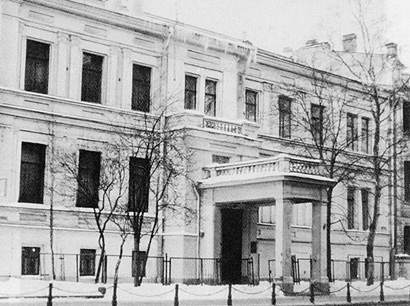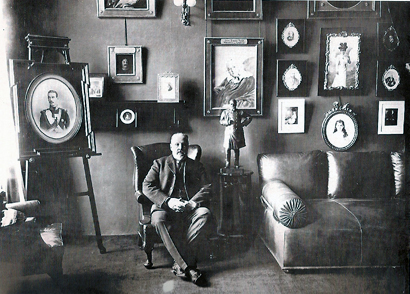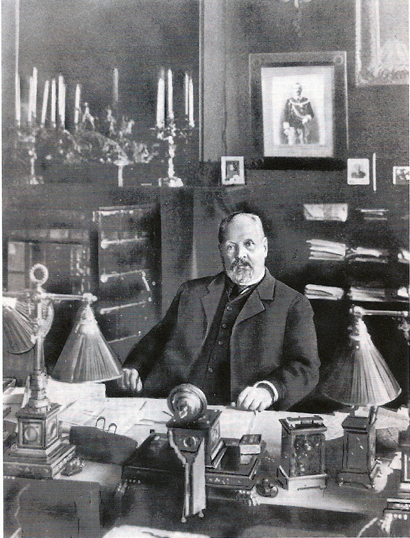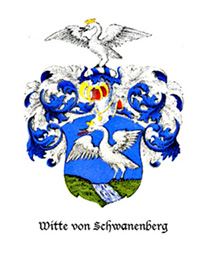RAILWAY COUNT WITTE (1849-1915)

COUNT SERGEI VON WITTE (1849-1915)
- Candidate in the physico-mathematical sciences at Novorossiisk University, Dissertation: “On Infinitesimal Quantities
- Minister of Ways and Communication (1891-1892):
- Minister of Finance (1892-1903)
- Prime Minister (1905-1906)
Count Sergei Witte; (1849-1915) was one of the most remarkable European statesman of the 19th century. He was the first statesman who introduced Capitalism or Market Economy in Eurasia (imperial Russia) and his modernization and industrialization plan as Minister of Finance and Prime Minister (1892-1903; 1905-1906) was implemented after Western example and his natural bias was liberal pro-Western. “As minister of finance I was also in charge of our commerce and industry. As such I increased our industry threefold. This again is held against me. Fools! It is said I took artificial measures to develop our industry. What a silly phrase! How else can one develop an industry?” (T. von Laue, Sergei Witte and Industrialization of Russia, U.S.A 1969).
Count Witte left his life work “The Witte System” for the later generation to pass judgment on his work and his greatest wish was that his “System” would live further. The term “System” characterizes a complete course of action, which is as coherent as a well-integrated and strong-willed personality can make it. Personality is expanded into an economic system V. (WittschefskyHandels-, Zoll-, und Industriepolitik). (T. von Laue, Sergei Witte and Industrialization of Russia, U.S.A 1969 P. 71).
FROM OUR FAMILY ALBUM



The basic plan of the Witte System remained a simple one: “Extensive railroad construction would stimulate the growth of the metallurgical and fuel industries supplying rails and other equipment. In turn, the expansion of the heavy industries would create favorable conditions for the growth of the light industries. (…) Railroad construction thus served as the flywheel for the entire economy”. . Theodore H. von Laue, Sergei Witte and the industrialisation of Russia U.S:A 1969 P. 77
During the last years of imperial Russia (1890-1915) the economy was going through a strong Westernization and it was no accident that almost all finance ministers 19th century bore Western in particular “German” names: Egor Frantsevich Kankrin (1823-44), whose real name was Krebs; Mikhail Kristoforovich Reutern (1862-78); Nikolai Kristoforovich Bunge (1882-80); or Sergei Iulevich Witte (1892-1903). All these men stood for modernization of Russia after Western example; their natural bias was liberal pro-Western. The ability to push change had fertile ground as no Minster of Finance had faced assassination, which indicated that the role was respected and there was an ambiance of trust in the office. In a study of impact of industrialization upon the Russian government, the figure of the Minister of Finance occupied the center. This view has been shared also by Theodore von Laue, 1969 pp. 4-5. But Sergei Witte benefited from a long period of preparation. According to the Schiller Institute studies, a small but powerful faction in the Russian Ministry of Finance was growing and even among the countries entrepreneurs, which were followers of “American System”. Mikhail A. Reutern, Witte’s predecessor was a student of Henry C. Carey’s economics. Reutern emphasized that without railways and mechanical industries, Russia cannot be considered secure in her boundaries. Thus Sergei Witte’s views and efforts were already strongly supported by predecessors before him. This crucial to his work and successes of his time.
Russia also looked to the United States after the civil war for examples of the benefits that foreign capital investment could bring to national economy.
So how did Finance Minister Witte intend to “tailor” the new economic model in Russia? Witte thoughts of developing Russia was in line with the German economist Friedrich List’s ideas. Friedrich List’s work of “National System of Political Economy” were in Witte’s opinion “the solution for Russia” where Witte shared List’s view, that the railroads were vital for large-scale national development, and for drawing the rural population into an increasingly urban-oriented society.
It was in America that Friedrich List gathered inspiration from a study of Alexander Hamilton’s work. This got him recognized as an economist in Germany for promoting the “National System”, views which he had adopted during his stay in the U.S from Henry Clay’s American System. Sergei Witte´s conviction was also in line with List´s ideas of using protectionism as the state policy to stimulate the entire economy. To support industry and oppose free trade, protectionism would shelter Russia’s weak “infant industries” against import from abroad… “in a country as Russia the task of economic policy at present lies in an energetic and resolute protectionism. The effectiveness of such a policy is guaranteed by the gifts of industry, of the people and the inexhaustible riches of the country, which offers the fullest possibility of producing almost all consumer goods under the most advantageous conditions.” ((Sergei Witte, Lectures on National and State Economy). T. von Laue, Sergei Witte and Industrialization of Russia, U.S.A 1969 p. p. 71).
Witte defended according to the American System tariffs and commercial treaties to raise revenues, foster international commerce and foreign capital investments. The “national industry” was focusing on metallurgy, textiles and chemicals. Witte’s currency reform, to fix ruble to the gold coin, made ruble a convertible currency. This guaranteed influx of foreign credits and investments. Sergei Witte also reorganized the significance of the State Bank issuing loans for the growth strategy and created network of state savings banks for the industry. Witte’s core idea was to implement a full-scale plan of constructing railroads extending across Eurasia toward the Pacific. An entire system of main and secondary railroad lines should be built, connecting the regions enabling the growth of national wealth. With the help of all types of railroads, the slogan was (…) “Make Russia TRANSITABLE. (professor Francis W. Wcislo, Tales of Imperial Russia U.S.A 2011 pp. 162-163.
p. 158 Within the Ministry of Finances, the fullest accounting of these structural shifts, and the strategies the ministry was developing to leverage them, was written in January 1896 for the ministry’s General Chancellery. This seventy-page abstract of a program and survey of all ministerial policy since Witte had assumed office in 1892 was a text that the minister reviewed and approved for publication. It is the fullest and most succinct explication of Witte’s vision of the imperial Russian professor Francis W. Wcislo, Tales of Imperial Russia U.S.A 2011 p. 158
p. 158 The ministry proclaimed its program to be the expansion of the economic well-being of the population as the only pathway to improving the national economy and assuring its future growth. In utilitarian language that valued capital, labor, and commodities, the report argued that personal and national wealth within the empire derived from accelerating the exploration of Russia’s rich but often underutilized, even “dormant” natural and human resources. To accomplish that goal required increased capital investments in the imperial economy. Investment increased production of mineral and agricultural commodities, as well as manufactured goods. Expanding wealth throughout the economy in turn created greater market demand and consumption. This increased circulation of capital, goods, and labor was already creating more favourable conditions of action for all participants of the national economy, the report maintained. The economy, in short, was creating conditions for its won self-sustaining expansion – although nothing here suggested a contradiction between that goal and a continuing significant role for the state as economic arbiter and investor. Indeed because this report surveyed not only every sector of the imperial economy, but also the commercial-industrial business culture each created, what was also evident in the text was just how sweeping were the statist impulses now governing Witte’s thinking. To achieve his vision of a modern imperial economy required the transformation of Russian commercial-industrial life. Not even that was beyond Witte’s dreams in this gilded age. (F. W. Wcislo U.S.A 2011 professor Francis W. Wcislo, Tales of Imperial Russia U.S.A 2011 p. 158
P 161 In terms of seeking out markets, commercial expansion in the natural sphere of Russian political and commercial influence in the countries of the east which are in close proximity to us and are less cultured, the report proclaimed, is an immediate priority. Central to that vision, as we have seen, was the Trans-Siberian Railroad. The “great Siberian way” would foster Russian interests in Asia by opening free access for the products of Russian industry to its huge markets (…) and (…) channelling the great traffic of cultured Europe through Russia to the far east. Population from European Russia would be resettled “into Sibera and east”, thereby assuring that, given the Russian people’s penchant for colonization our might is created and strengthened. professor Francis W. Wcislo, Tales of Imperial Russia U.S.A 2011 p. 161
